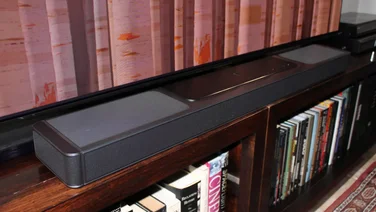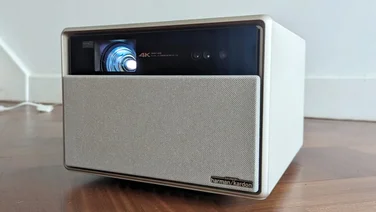To help us provide you with free impartial advice, we may earn a commission if you buy through links on our site. Learn more








Last year, XGIMI followed up its brilliant MoGo2 and MoGo 2 Pro projectors with its most innovative portables yet. The MoGo 3 and MoGo 3 Pro were transforming, cylindrical sci-fi projectors where the top part pulled away from the base on an extending stalk, then rotated to reveal a lens primed to beam your favourite movies at the nearest screen. It was a quirky but ingenious design, complete with party tricks that enabled it to double as a Bluetooth speaker, or project cool, ambient visuals onto nearby walls.
The new XGIMI MoGo 4 takes last year’s design and refines it, changing little in terms of the visual specs, but adds a built-in battery and addresses the MoGo 3’s weakest point: audio.
Meanwhile, a higher-end version, the MoGo 4 Laser, promises to boost brightness and clarity with the aid of a three Laser optical system and a brightness boost to 550 ISO Lumens. I’ve yet to see the Laser model in action, but I’ve had the chance to go hands-on with the LED-based MoGo 4 at a Paris event, with a couple of days beforehand to check it out at home. It’s still too early to give a definitive verdict, but it’s looking like a strong contender for our Best Portable Projectors guide.
XGIMI MoGo 4: Specifications, price and release date
| Optical engine | 1080p 0.23in DLP with LED backlight |
| Brightness | 450 ISO lumens |
| Contrast | Not specified |
| Throw ratio | 1.2:1 |
| Lens | High-light transmission coated |
| Audio standards support | Dolby Audio, Dolby Digital, Dolby Digital+ |
| Speakers | Built-in 2 x 6W Harman/Kardon speakers |
| Accessories | Remote and infra-red mini remote, Sunset filter, Optional PowerBase stand |
| Software | Integrated Google TV |
| Price | £509 |
| Release date | 21 May, 2025 |
Key features and first impressions
As I said, this isn’t a massive redesign. The MoGo 4 repeats the two-part design of the MoGo 3 and MoGo 3 Pro, with the top of the unit pulling away from the base, then swivelling to point at the screen from a range of angles. Even here, there are some improvements; here last year’s model could point in a 130 degree arc, this year’s can rotate through a full 360 degrees. At 207.6mm tall and 96.5 across, the cylinder is a little taller and wider than on the MoGo 3, though the redesigned base of the unit appears slightly smaller to the eye.
The projector activates automatically once open, with the auto-keystone and auto-focus technology kicking in as soon as it’s pointed at a screen or wall. XGIMI’s ISA processing handled this stuff almost perfectly last year, and does much the same this year, making it ludicrously easy to get a decent image from any sensible angle. Sure, you’ll lose a little corner focus and definition if you’re projecting too far off centre on one axis, but it’s basically point and project.








The MoGo 4 has the same 1.2:1 throw ratio as the MoGo 3 Pro, giving you a 100in image from a 2.66m distance or a 60in image from 1.6m. XGIMI claims the projector can display images of up to 200in in size, but I wouldn’t want to push it that far; you’re going to lose some a fair amount of brightness and contrast beyond 120in.
Also like last year’s model, the MoGo 4 can double as a Bluetooth speaker, with a cool ambient glow in your choice of six colours. Previously, this could shine quite brightly through a gap between the body of the projector and the base, but XGIMI has redesigned the latter as a translucent section, diffusing the light so it’s less fierce and a little more party friendly.
Watching the projector in action at XGIMI’s launch event – and checking out some snippets of TV shows and movies while at home – I can say that image quality is pretty impressive given that this is the entry level version of the two new MoGo models, with the MoGo 4 Laser taking over from the MoGo Pro.








While the 450 ISO Lumens brightness level means it’s never going to compete with more powerful home cinema projectors, it can still deliver sharp and vibrant 1080p images with natural colours, struggling a little in ambient lighting, but holding up well in a darkened room. You’re not getting 4K levels of definition, either, but clarity is impressive for a portable model, and the picture holds up pretty well, without obnoxious pixelation, even at sizes of over 60in.
Crucially, the speakers have been improved over the MoGo 3 Pro, which I found could get harsh and brittle at high volumes, with dialogue sometimes difficult to hear in busy scenes. It’s still not as beefy, rich or well-balanced as on XGIMI’s higher-end Horizon series, but there’s still more depth and bass than there was, and I had no issues watching Mission Impossible: Dead Reckoning or The Four Seasons on Netflix. The driving score and high-impact sound effects of the former had plenty of punch and drama, while the music and dialogue of the latter were clear and showed some capacity for subtlety and nuance.
What’s more, it works a little better as a Bluetooth speaker, going loud enough to power through a party without dishing out a painful racket. I’ll wait to complete my full range of tests before delivering a verdict, but right now the MoGo 3 Pro looks and sounds as good as portable projectors get.








The MoGo 3 shipped with a single, physical filter, which you could attach to the projector and, through an app, beam ambient lightscapes into your room. The MoGo 4 now comes with the “sunset” filter, which gives you a graduated, glowing circle that changes colour when you flick your hand in front of the lens. Three more are available – all four are included with the Laser model – and they now attach using magnets, so they’re faster and easier to switch.
I’ll admit this concept is wasted on me, much like XGIMI’s description of the MoGo 4 as a “vibes machine”. However, the idea seems to be to bring projectors to a younger audience who might appreciate its mood-creating skills, and I can see the MoGo 4 doing just that. Meanwhile, even a grumpy git like me who hasn’t experienced vibes this century can appreciate XGIMI’s bonus mini remote, which clings to the projector with it’s own lanyard and handles basic volume controls and selection duties when you don’t have the standard remote to hand.








Like the MoGo 3, the MoGo 4 incorporates Google TV streaming over Wi-Fi 5. This is a slick experience and very easy to set up if you have the Google Home app on your Android smartphone or iPhone – without it, you will need to enter your network credentials and Google Account details by hand. Most major streaming services, including Netflix, are supported, although I will have to to check whether all the UK catch-up TV services are onboard this time.
The MoGo 2 and MoGo 3 projectors missed one crucial piece of the portable projector puzzle. With no built-in battery, you could only use them outside or on the move with a mains extension cable, a 65W output power bank or XGIMI’s own PowerBase stand. That changes with the MoGo 4 series, where both projectors have an internal battery that lasts a claimed “up to two and a half hours” of video playback or “up to six hours” of music only. If that’s not enough to get you through the latest overstuffed blockbuster, you can still double the video playback time by adding a PowerBase stand.
XGIMI MoGo 4 hands-on review: Early verdict
I’m pretty impressed with the MoGo 4. True, it’s a little bigger and less portable than the lovable Anker Capsule 3, but it’s also substantially brighter and might just have its rival beaten on overall image and sound quality.
Both were already good on the MoGo 3 and MoGo 3 Pro, but the MoGo 4 might have a slight edge when it comes to images and even more so on the audio front. Throw in a battery for full-on mobile use, and it could be XGIMI’s best portable projector yet.
The only question is whether the MoGo 4 Laser’s higher brightness levels and sharper contrast will justify the higher £679 price point, and risk leaving the LED model in the shade.














